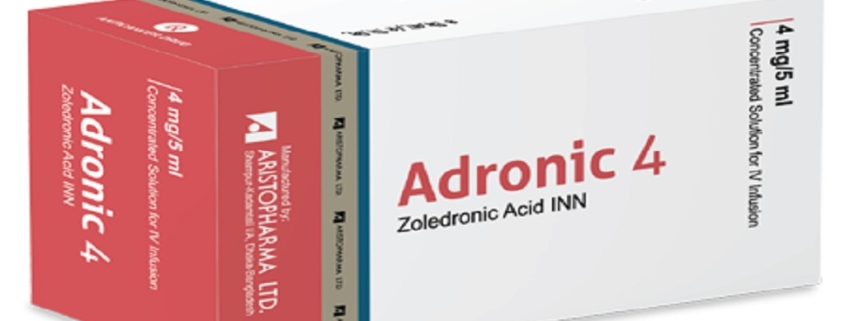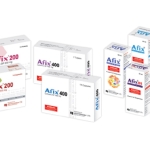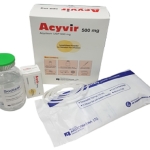Adronic (Zoledronic Acid)
Zoledronic Acid, belongs to a group of medicines called bisphosphonates. It is an inhibitor of osteoclast-mediated bone resorption. The action of bisphosphonates on bone is based on their high affinity for mineralized bone.
Description
The active ingredient in Adronic is Zoledronic Acid, which belongs to a group of medicines called bisphosphonates. It is an inhibitor of osteoclast-mediated bone resorption. The action of bisphosphonates on bone is based on their high affinity for mineralized bone. Intravenously administered Zoledronic Acid is rapidly distributed to bone. Zoledronic Acid is not metabolized and is excreted unchanged via the kidney.

Presentation
Adronic 4 Concentrated Solution for IV Infusion:
Each vial contains Zoledronic Acid Monohydrate INN 4.264 mg equivalent to Zoledronic Acid 4 mg supplied as 5 ml concentrated solution for IV infusion.
Indications
Zoledronic Acid is a bisphosphonate indicated for the treatment of:
• Hypercalcemia of malignancy.
• Patients with multiple myeloma and patients with documented bone metastases from solid tumors, in conjunction with standard antineoplastic therapy. Prostate cancer should have progressed after treatment with at least one hormonal therapy.
Limitation of use: The safety and efficacy of Zoledronic Acid have not been established for use in hyperparathyroidism or nontumor-related hypercalcemia.
Dosage & Administration
Hypercalcemia of malignancy
- 4 mg as a single-use intravenous infusion over no less than 15 minutes.
- 4 mg as retreatment after a minimum of 7 days.
Multiple myeloma and bone metastasis from solid tumors
• 4 mg as a single-use intravenous infusion over no less than 15 minutes every 3-4 weeks for patients with creatinine clearance of greater than 60 ml/min.
• Reduce the dose for patients with renal impairment.
• Coadminister oral calcium supplements of 500 mg and a multiple vitamin containing 400 international units of Vitamin D daily.
Administer through a separate vented infusion line and do not allow to come in contact with any calcium or divalent cation-containing solutions.
Contrainidications
Contraindicated in patients with known hypersensitivity to Zoledronic Acid.
Warning & Precautions
Pregnancy: Zoledronic Acid may cause fetal harm when administered to a pregnant woman. If this drug is used during pregnancy, or if the patient becomes pregnant while taking this drug, the patient should be apprised of the potential hazard to a fetus.
Nursing mothers: It is not known whether Zoledronic Acid is excreted in human milk. Because many drugs are excreted in human milk, and because of the potential for serious adverse reactions in nursing infants from Zoledronic Acid, a decision should be made to discontinue nursing or to discontinue the drug, taking into account the importance of the drug to the mother. Zoledronic Acid binds to bone long-term and may be released over weeks to years.
Pediatric use: Zoledronic Acid is not indicated for use in children.
Geriatric use: No significant differences in response rate or adverse reactions have been observed in patients aged 65 years or older receiving Zoledronic Acid as compared to younger patients. Because decreased renal function occurs more commonly in the elderly, special care should be taken to monitor renal function.
Side effects
The most common adverse events (greater than 25%) are nausea, fatigue, anemia, bone pain, constipation, fever, vomiting, and dyspnea.
Drug interaction
Aminoglycosides may have an additive effect to lower serum calcium for prolonged periods. Concomitant use of Loop diuretics with Zoledronic Acid may increase the risk of hypocalcemia.
Use in special groups
Packing
Adronic 4 Concentrated Solution for IV Infusion: Each box contains a single-dose glass vial of Zoledronic Acid 4 mg.




